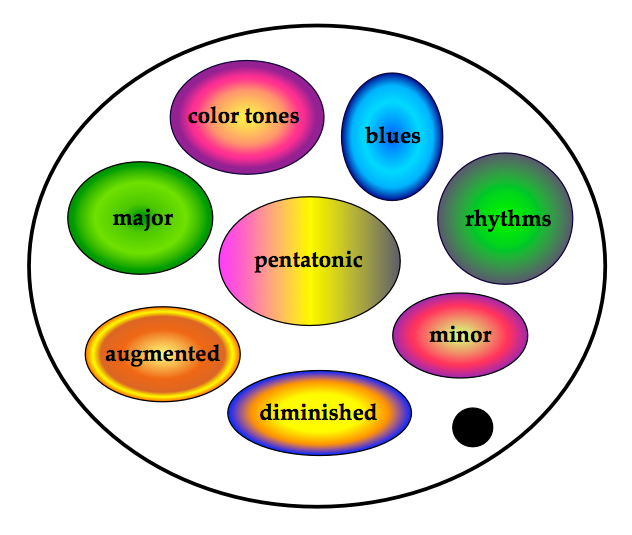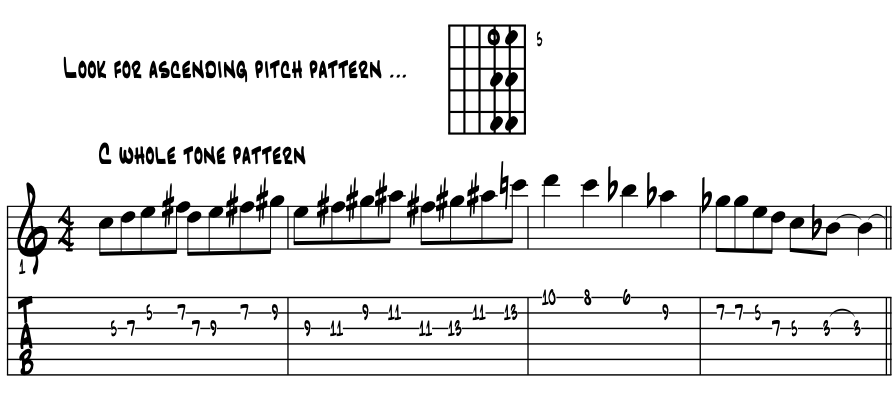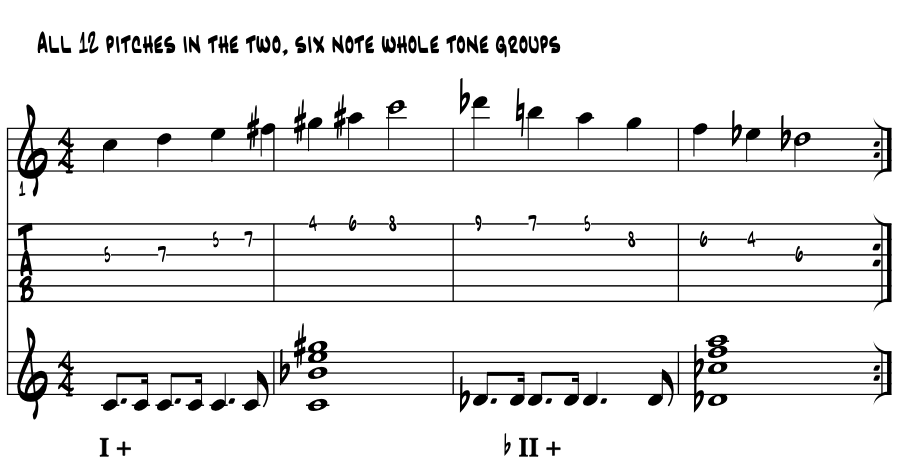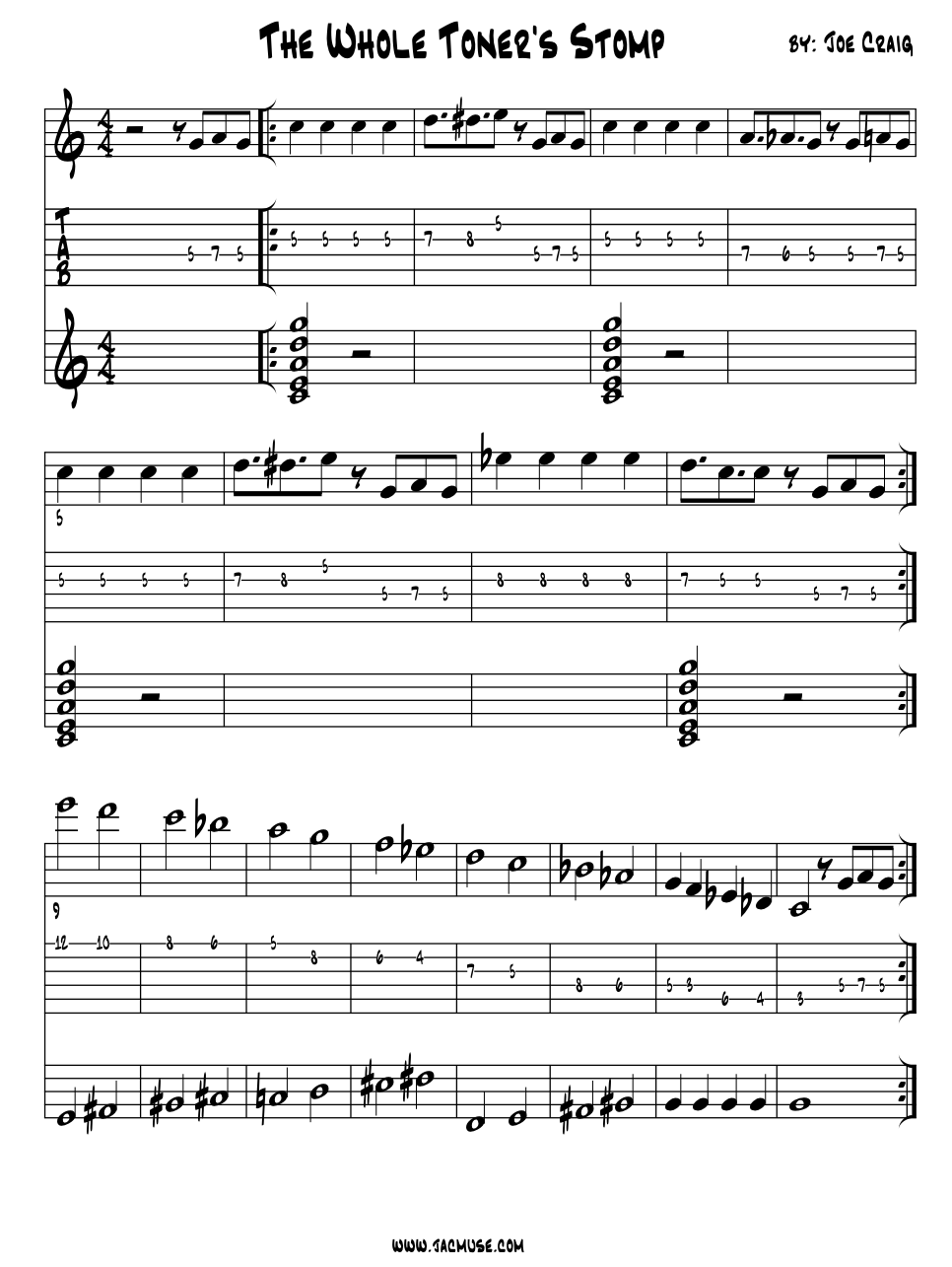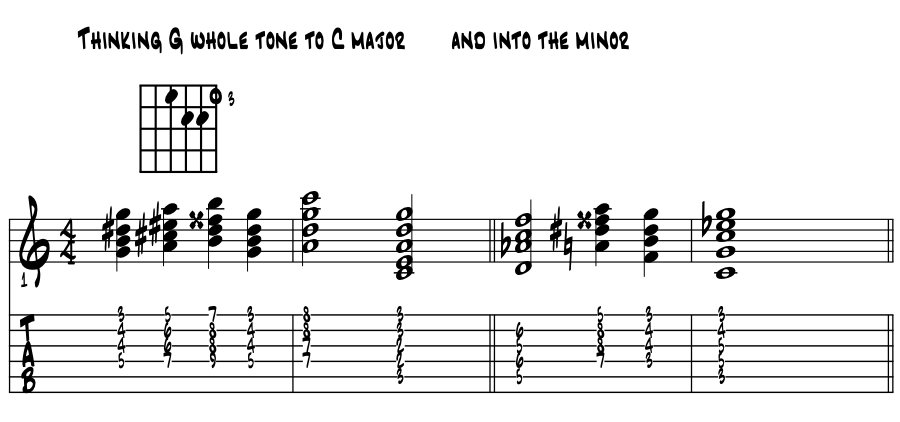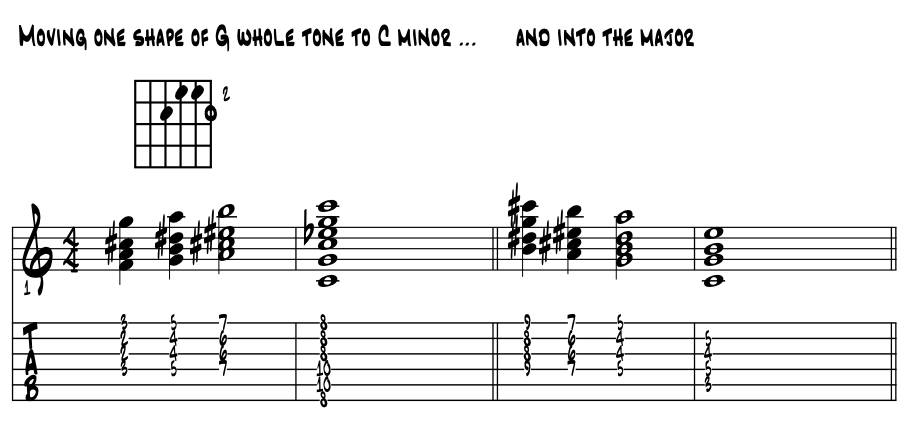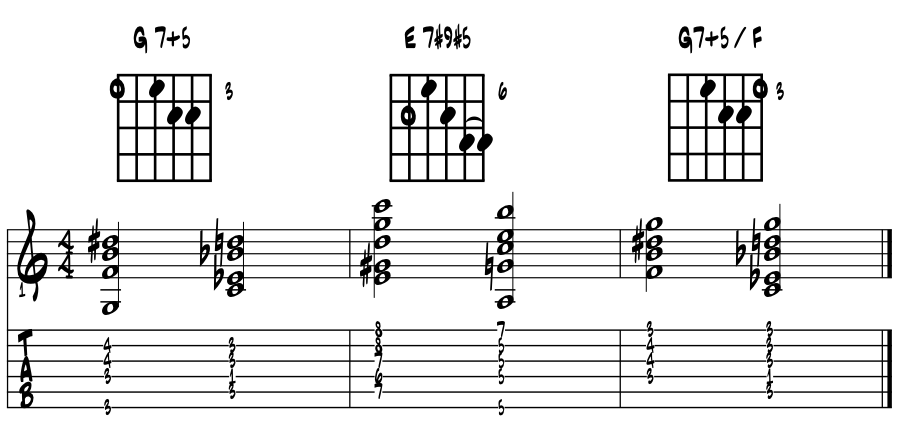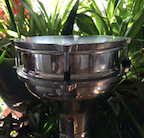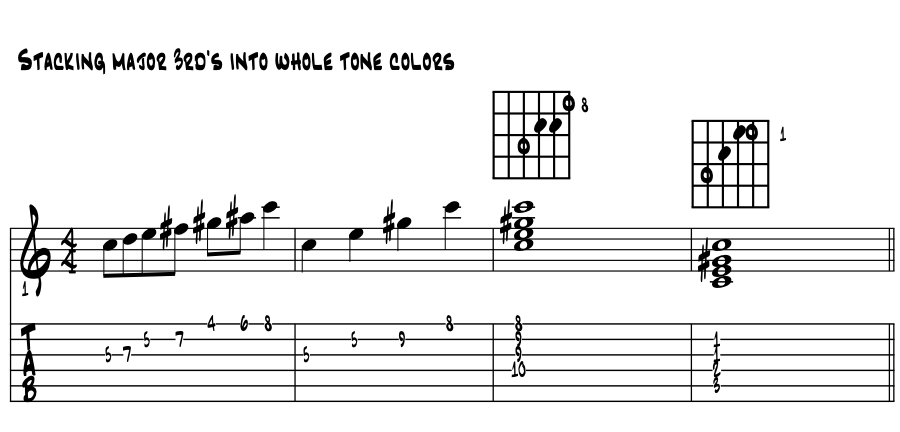In a nutshell ~ 'whole tone.' The whole tone color is, as its name implies, created from a sequential pattern of just whole steps. ~ '1 1 1 1 1 1.' ~ , six whole steps to create 'closed loop' / group of pitches. Mostly a blues and jazz color in melodies, in the blues we mix it into chords, and find it in a rare spot or two in pop music. More common in minor keyed songs than major, again especially in the blues chords and progressions, to create the whole tone scale we simply choose a starting pitch and whole step our way to perfect octave closure. Please examine the letter name pitches and their musical sound. Example 1. |
scale degrees |
1 |
2 |
3 |
4 |
5 |
6 |
8 |
C major pitches |
C |
D |
E |
F# |
G# |
A# / Bb |
C |
whole steps |
1 |
1 |
1 |
1 |
1 |
1 |
Sound familiar? Click it again and sing along. For like the challenges of singing the chromatic scale, the whole tone color is tricky and strengthening at the same time too. Here's an whole tone lick based on a two string pattern that move up by whole steps. Example 1a. |
scale degrees |
1 |
2 |
3 |
4 |
5 |
6 |
8 |
C whole tone pitches |
C |
D |
E |
F# |
G# |
A# / Bb |
C |
Not a whole lot of music there really, just a tongue twister to get us to sing in ways we might not ordinarily do, for practice, a challenge and fun. |
Easy Two / Five / One wholetone morph. Just a recent discovery for a 2 / 5 / 1 lick with the whole tone color. Thinking 'C' major; run the 'A' natural minor's pitches, (relative to C major) over the 'D' min 9 chord ( ii-9), then morph the 'A' natural minor into 'A' wholetone group of pitches / scale :) Please examine the chart of the three scale's letter names and hear a basic 'morph' riff of these colors towards a resolution to 'C' major. Example 1a. |
scale degrees |
1 |
2 |
3 |
4 |
5 |
6 |
7 |
8 |
A natural minor / D - 9 |
A |
B |
C |
D |
E |
F |
G |
A |
A whole tone / G7+ |
A |
B |
C# |
D# |
E# (F) |
G |
A |
|
C major ~ Ionian / C maj 7 |
C |
D |
E |
F |
G |
A |
B |
C |
Cool ? |
Two whole tone scales only. When we run out the pitches of the 'C' whole tone scale we count six different pitches. So if we have just in total have the 12 pitches, we've then six remaining. And six is how many we need to make this whole tone scale yes? Think they might conjure up a whole scale too ? Starting with the pitch between 'C' and 'D', so 'Db', and 'whole stepping' our way into town, the new magic emerges :) Do examine the letter name pitches and resulting sounds. Ex. 2. |
scale degrees |
1 |
2 |
3 |
4 |
5 |
6 |
8 |
C whole tone pitches |
C |
D |
E |
F# |
G# |
A# / Bb |
C |
Db whole tone |
Db |
Eb |
F |
G |
A |
B |
Db |
Interesting huh? Sure enough perfect closure from 'Db.' And if our building interval is exclusively the whole step, from each of the pitches of each of the scales we can create the same symmetrical pattern of pitches. There's got to be some coolness in this 'perfection of pitches' somewhere, might just have to find a way in ... hmmm ? |
A whole tone bridge. So while putting this discussion together this song came along. Written as a 30's styled 'head' tune in a rhythm changes 32 bar form, the bridge is cool as the cycle of V7 from Three above our tonic chords finds us alternating between the two different whole tone scales awhile approaching the root pitch of each of the four chords by half step from above. Example 3. |
Some contrary motion there ... in more ways that one ! These rhythm changes / jump tunes are easy and fun to create. Jazz players will know the form, so once the 'motif' is discovered, it'll bolt right into this 32 form. We do this with writing blues songs too, one four bar phrase three times and we're good to go :) |
And just the one scale shape for whole tone? Well ... When it comes to whole toning around, personally the notes on the 5th and 6th strings are tough to fit in so tend to be omitted. That the upper ones are so cool probably plays a part in this too. So this one whole tone scale shape has all the pitches and by the look of it, a few symmetrical looking patterns for licks and chords built right into it, clear as day by looking at the dots. Plus with the symmetrical potentials of two and three notes per string, it's potentially a blazer. Example 4. |
And there must be a couple of chords ... From the look of this shape there's a couple of easy chords that come right along. And that we are total whole tone / whole step here, we can move them around by whole steps, jazz it up a little, and still stay fairly within our tonal bounds. Here's the first of two common shapes, thinking 'G'7+5 into 'C' major and minor. Example 4a. |
The second shape. This next idea just flips the last shape over, changing up our color tones etc. in the voicing. Again the half step motion to resolve. Ex. 4b. |
Big miles in these last two ideas depending, just lots of ways to nuance the shapes and resulting colors. And these might be the only double sharps in the book :) |
Same movability ability with diminished? Yea pretty much. The diminished color is based on the minor 3rd, so we can whole step, half step it or move by three frets for the minor 3rd interval. Moving the one shape up and down the neck is the neat trick here. Example 4c. |
Cool? So in the jazz world, these two colors and their symmetrical motions open up a wide vista of aural opportunity to move things about, often towards some sort of tension / release of a tonal center. |
In a nutshell / to 'augment.' The core definition of 'augment' includes to make something bigger, to enlarge and otherwise fortify a thing in whatever way seems appropriate. In our musics, we generally 'augment' components by making the spaces between our pitches a wee bit bigger than we would normally find them. Initially we only assign the term augment to our perfect intervals and the motion is by half step. Behold the noble character of the perfect 5th interval augmented by half step. Thinking 'C' major. Example 5. |
scale degrees |
1 |
2 |
3 |
4 |
5 |
6 |
7 |
8 |
C major pitches |
C |
. |
. |
. |
G |
. |
. |
C |
scale degrees |
1 |
2 |
3 |
4 |
aug 5 |
6 |
7 |
8 |
C major pitches |
C |
. |
. |
. |
G# |
. |
. |
C |
Here the direction of the line? Our augmented colors are very character, one of a kind sounds. Not that everything isn't, but the augmented whole tone colors once clearly recognized and understood, become fairly identifiable when slipped into our musics. Example 5a. |
Makes for a solid intro yes? Sort of 'secret agent man' styled from wayback or a lovely Latin romp. |
Where in the music. The augmented and whole tone colors are today most in the jazz musics. That said, there's some very common spots in the literature that feature an augmented triad or V7+5. This first two bars of the motion of One to Four features the augmented triad. Measures 3 and 4 follow with Four / Five / One in a minor key. Example 6. |
This motion from One to Four using the augmented 5th is probably the most common of our '+5' motions. In using this passing tone, chromatic motion, we're moving by half step between triad or chord tones. So as solid and directional as it might ever get. The augmented 5th on V7 gives us a common tone when moving from Five to One in a minor key. This common tone of the 'blue 3rd', a strong and passionate bridge between these two essential chords, while mostly a blues and jazz thing, is found throughout all of our styles. |
V7+5 to One. These next three V7+5 chord shapes are among the most common through the our Americana blues and jazz literature. Completely movable up and down the neck, keep track of what root pitch you need and they'll work every time. At least as a start point depending on who is in your mix. Ex. 6a. |
In pop music. These last two ideas just seem to get the most mileage of our whole tone colors through our Americana musics. Stevie Wonder's essential cover of "For Once In My Life", as the opening chord for "Oh Darling", the Beatles' gem. And in the minor moods, the rather common V7+5 to close a section and start anew. "This Masquerade", blues, pop and jazz pianist Leon Russell's classic. Here's a classic Americana augmented chord lick, sounding out for some 'curiosity to come' for the song's intro and story beyond, arpeggiated to perfection by guitarist Ben Heller in his 2024 song "The Apostate." |
|
Stacking major 3rd's. In stacking up a couple of whole steps we create the major 3rd interval. Put a couple of these together and we build up an augmented triad. Please examine the letter name pitches and resulting sounds. Thinking 'C' major. Example 7. |
scale degrees |
1 |
2 |
3 |
4 |
5 |
6 |
8 |
C whole tone pitches |
C |
D |
E |
F# |
G# |
A# / Bb |
C |
C whole tone triad |
C |
. |
E |
. |
G# |
. |
C |
Ah ... that perfect closure in three leaps. Yet again we see the perfect closure of our theory machinations. That no matter how unique a combination of pitches might ever be, if we follow along its interval sequence of pitches long enough, we'll eventually find our original starting point. Longest of journeys? Start with one step. Returning back home? As our earth is round, just keep walking and eventually we'll get there :) |
Add a 7th. Just like any chord, we can add a 7th colortone to our triads. And while we explore what's possible here with the pitches, only the major triad with an augmented 5th and a blue 7th gets gets any kind of attention in our mainstream folk / blues / country / pop / jazz based Americana weave. Example 8. |
scale degrees |
1 |
2 |
3 |
4 |
5 |
6 |
7 |
8 |
C major pitches |
C |
D |
E |
F |
G |
A |
B |
C |
C major triad / maj 7 |
C |
. |
E |
. |
G# |
. |
B |
. |
C major triad / b7 |
C |
. |
E |
. |
G# |
. |
Bb |
. |
C minor triad / maj 7 |
C |
. |
Eb |
. |
G# |
. |
B |
. |
C minor triad / b 7 |
C |
. |
Eb |
. |
G# |
. |
Bb |
. |
Tonal whole tone instability. In addition to these colors, there's also tonic major 7 / b5, which is also found up one octave as the #11. These chords are a tonic function jazz color that often just precedes a stronger resolution, created by sounding the perfect 5th within the diatonic One chord. |
'Elided' is the term we can apply here for these 'paused' resolutions, to 'elide' a cadential motion. Euro influenced jazz pianist Bill Evans was among the first of the masters of this sort of disguise. His contribution to the Miles Davis recording "Kind Of Blue' helping to define a new artistic direction for jazz in the early 60's. Other areas we elide are in time and rhythms, as we look to 'make the bar lines go away.' Here we can easily enter into the 'cool Latin jazz' of the 1980's and beyond, with artists such as Pat Metheny leading the way. |
|
The whole tone colors just have a way of creating those ... 'oh oh ... now what ...?' cliche moments, especially in movie scores. Knowing of the color will help us to locate this piece when needed for one of our puzzles. |
"Giant Steps." While most of our musical compositions are based around diatonic motions and cycling roots by perfect 4th, there is one song that is clearly based on the augmented major triad. John Coltrane's jazz song titled "Giant Steps" creates a key center on each of the pitches of the augmented triad, then merrily bops on along in a rather high degree of joyous expression. The copyrighted song is written without key signature and based on an 'Eb' augmented triad. So let's modulate over there for clarity sakes and ease of transfer for those who will learn the song. Please examine the pitches and perfect closure of the major 3rd cycling. Example 9. |
|
scale degrees |
1 |
2 |
3 |
4 |
5 |
6 |
8 |
Eb whole tone pitches |
Eb |
F |
G |
A |
B |
Db |
Eb |
Eb whole tone triad |
Eb |
. |
G |
. |
B |
. |
Eb |
G whole tone triad |
. |
. |
G |
. |
B |
. |
D# / Eb |
B whole tone triad |
. |
. |
F## / G |
. |
B |
. |
D# / Eb |
Let's do a quick respell here for clarity sakes :) |
triad degrees |
1 |
3 |
5 |
8 |
Eb whole tone triad |
Eb |
G |
B |
Eb |
G whole tone triad |
G |
B |
D# / Eb |
G |
B whole tone triad |
B |
D# / Eb |
F## / G |
B |
Well how cool is that ! We take three pitches, make three different rooted triads and form a loop. And surely then these must inversions of one another to boot. Find a recording of this now famous jazz song by Mr. Coltrane and marvel at how it theoretical simplicity had jaw dropping reverberations within the global jazz communities. For it reaches in a new direction for composition and in its improvisation sections, begins a new 'through the chords' approach to the improv by using the pentatonic color. |
Review. The whole tone color is a rare bird indeed. In trying to get some under our fingers, might be best to start with a chord, say V7+5 resolving to a minor key. Triad motion from One to Four is also a common spot, as we gain a passing tone to the major 3rd of the triad built on Four. Whole tone melodies tend to sound like whole tone melodies, so there's an artistic consideration in these lines, as being too 'color heavy' in a balanced, diatonically generated melody line. And in the augmented triad's evolutions as a 'new' compositional structure, consider learning "Giant Steps." For many reasons really, for it gets us to thinking differently in chord progressions and key centers within a song, and in our improvising lines through chord changes with its 'four note cell' approach. By working outside the norm, we'll evolve. |
“Nothing ever comes to one, that is worth having, except as the result of hard work.“ |
wiki ~ Booker T. Washington |
References. References for this page come from the included bibliography from formal music schools and the bandstand, made way easier by the folks along the way. In addition, books of classical literature; from Homer, Stendahl and Laudurie to Rand, Walker and Morrison and of today, provided additional life puzzle pieces to the musical ones, to shape the 'art' page and discussions of this book. Special thanks to PSUC musicology professor Dr. Y. Guibbory, who 40 years ago provided the initial insights of weaving the history of all the fine arts into one colossal story telling of the evolution of AmerAftroEurolatin musical arts. And to teacher-ed training master, Dr. Joyce Honeychurch of UAA, whose new ideas of education come to fruition in an e-book. |
"Life is about creating yourself." |
wiki ~ Bob Dylan |
Find an e-book mentor. Always good to have a mentor when learning about things new to us. And with music and its magics, nice to have a friend or two ask questions and collaborate with. Seek and ye shall find. Local high schools, libraries, friends and family, musicians in your home town ... just ask around, someone will know someone who knows someone about music who can help you with your studies of the musical arts with this e-book. |
Intensive tutoring. Luckily for musical artists like us, the learning dip of the 'covid years' can vanish quickly with intensive tutoring. For all disciplines; including all the sciences and the 'hands on' trade schools, that with tutoring, learning blossoms to 'catch us up.' In music ? The 'theory' of making musical art is built with just the 12 unique pitches, so easy to master with mentorship. And in 'practice ?' Luckily old school, the foundation that 'all responsibility for self betterment is ours alone.' Which in music, and same for all the arts, means to do what we really love to do ... to make music :) |
 |
"These books, and your capacity to understand them, are just the same in all places. Always bear in mind that your own resolution to succeed, is more important than any other one thing." |
|
Academia references of Alaska. And when you need university level answers to your questions and musings, and especially if you are considering a career in music and looking to continue your formal studies, begin to e-reach out to the Alaska University Music Campus communities and begin a dialogue with some of Alaska's finest resident maestros ! |
|
Formal academia references near your home. Let your fingers do the clicking to search and find the formal music academies in your own locale. |
"Who is responsible for your education ... ? |
'We energize our learning in life through natural curiosity and exploration, and in doing so, create our own pathways of discovery.' Comments or questions ? |
